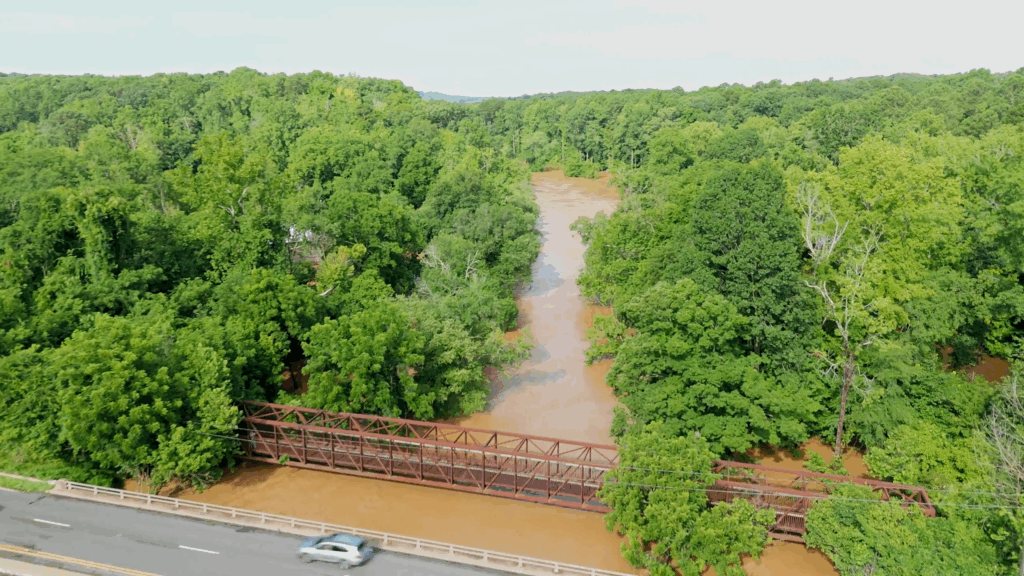As the Eno River Association’s Education Manager, I talk about climate change a lot through our programs, hikes, and summer camps. I talk about the ways in which climate change alters our water cycle and leads to intense and unpredictable storm systems. I talk about the potential for flood events and the importance of protecting land around the Eno River to promote climate resilience. I am saddened to say that the events that took place overnight on Sunday, July 6th have provided me with an extremely tangible example to point to when discussing what direct and localized effects of climate change might look like in our area.
I woke up that Monday to a deluge of texts detailing the flooding that had taken place overnight. In the coming hours and days, we continued to learn about people in our community and surrounding areas who had been affected by this storm. Cars and homes endured significant flood damage. Eighty residents had to be rescued by boat. Storefronts were left in shambles. Our beloved parks and preserves were underwater. Six people across the state lost their lives.
When all was said and done, rain gauge data showed that the Eno River’s water levels rose to an astounding 25.63 feet. This surpassed the record set by Hurricane Fran in 1996, which saw the river rise to 23.58 feet. A visual representation of this record-breaking rainfall was easily observable to anyone who saw the circulating photo of a sign in Eno River State Park stating, “The Eno River rose to the level of this sign post during Hurricane Fran on September 6, 1996.” Ironically, the water level covered the bottom half of the sign’s text.
Let’s talk Climate Science
We’ve all heard the warnings from climate scientists. The planet is warming at an unprecedented pace as a result of human activity and we are running out of time to prevent or reduce the worst of these effects. The long list of concerns includes sea level rise, heat-related illnesses, wildfire risk, and so on. At the top of this list in many parts of the world, including here in central North Carolina, is the increased likelihood of extreme weather events.
The painfully simple truth is that rising temperatures means greater rates of evaporation, which means more moisture in the atmosphere, which means more intense storms and heavier rainfall. At the same time, human-made alterations to landscapes—ranging from roads and buildings to agricultural fields—create ground surfaces that are unable or less able to absorb water. Together, these factors are a recipe for destructive flood events. It’s also important to note that historic and systemic racism has led to marginalized communities being relegated to low-lying areas that are more susceptible to flooding.
What is there to be done?
Without the persistent efforts of many community members since the 1960s, a lot of the land along the Eno River would have most likely been altered in ways that would have made this flood event even more catastrophic. Protecting natural ecosystems, preferably with Indigenous land management practices in mind, prevents destructive flooding. This is part of why our management plan at the Confluence Natural Area prioritizes Piedmont Prairie restoration. Native grasses and wildflowers have deep, fibrous root systems that are not only excellent at sequestering carbon, but also do a great job of absorbing rainfall and preventing erosion.
It can be difficult not to feel discouraged, overwhelmed, or resigned due to the clear indicators of climate change. It can also be difficult not to feel incredibly frustrated at those who impede progress in one way or another. But the best thing we can do is keep going, keep working, keep communicating with each other. Dr. Ayana Elizabeth Johnson recommends drawing a Venn diagram to find the sweet spot between what you are good at, what work needs doing, and what brings you joy.
I recently listened to an Ologies episode with Dr. Suzanne Pierre who runs the Critical Ecology Lab in California. Though the episode is a few years old, the lessons within are both timely and timeless. When asked about how she maintains hope in her line of work, Dr. Pierre states that:
“When we do radical things on a very micro level, to make sure that compassion is available, that that mutual care is there, those little behaviors and decisions in our regular lives spiral up to become very problematic for the systems that want us to be divided, oppressed, confused, alienated from one another, and alienated from ecosystems. When you make resources, care, and support more available to people, it builds solidarity across groups of difference.”
What can I do?
We don’t need to–and realistically cannot–solve systemic problems on our own. The list below provides opportunities to contribute to solutions, strengthen community, and support important work.





